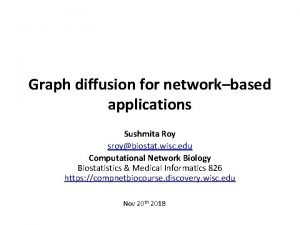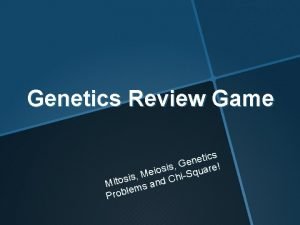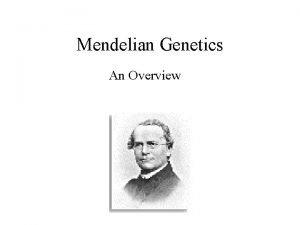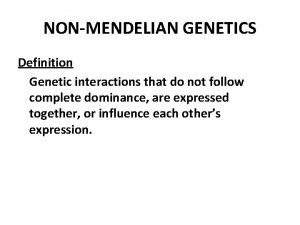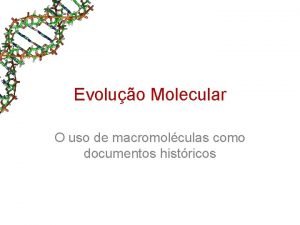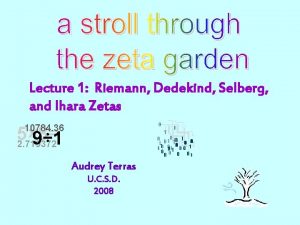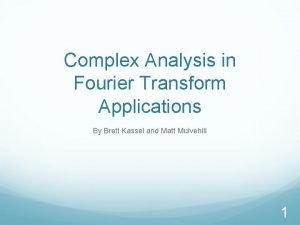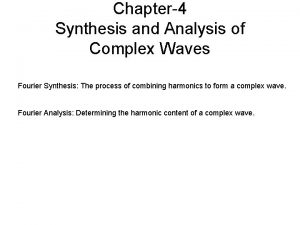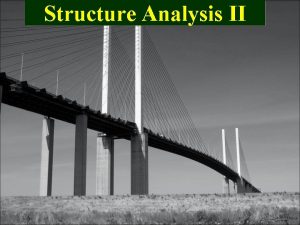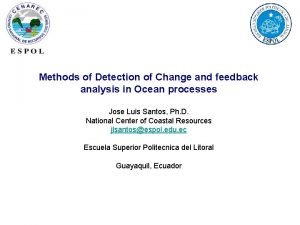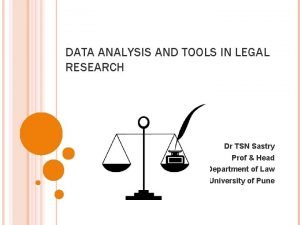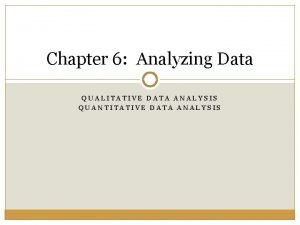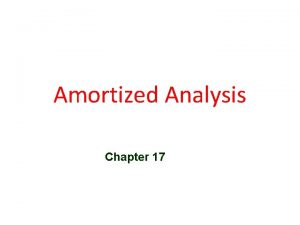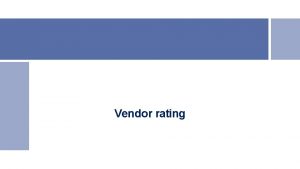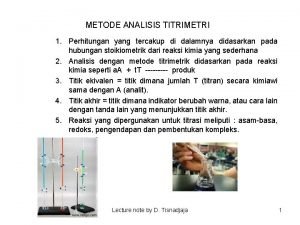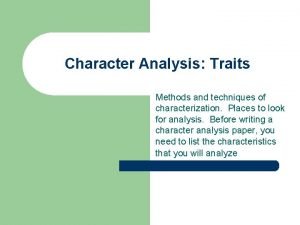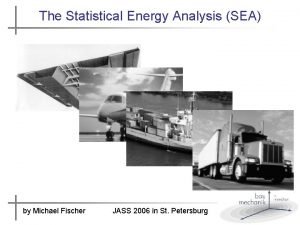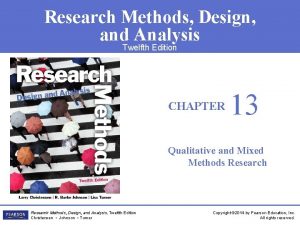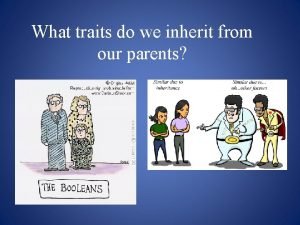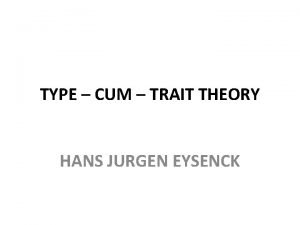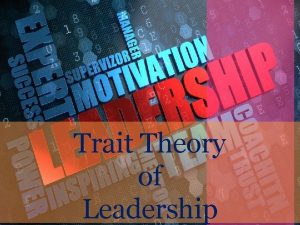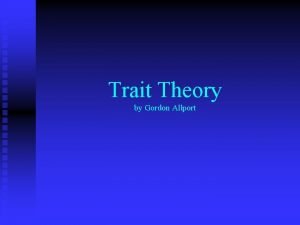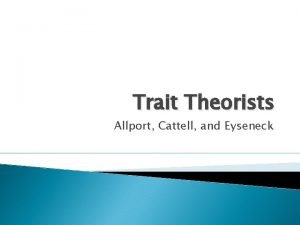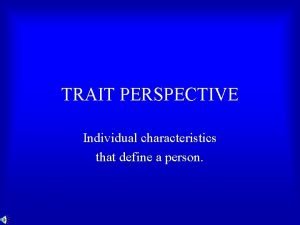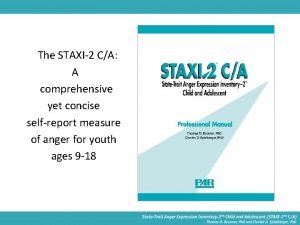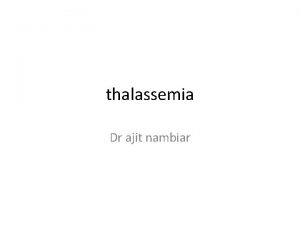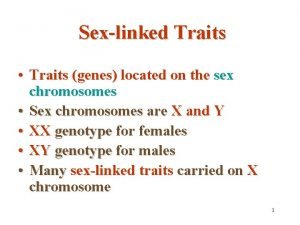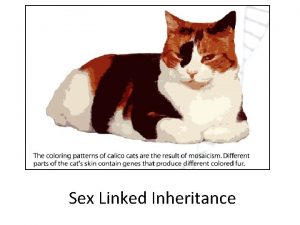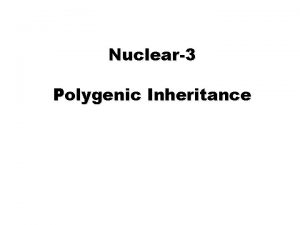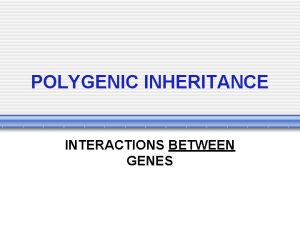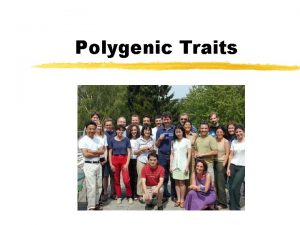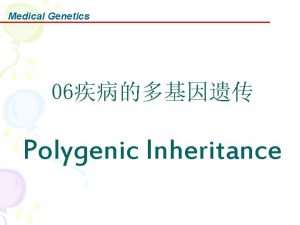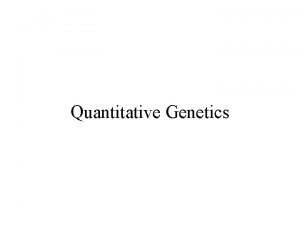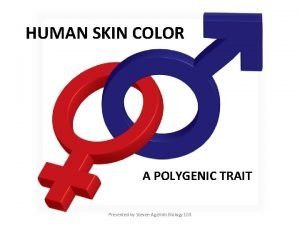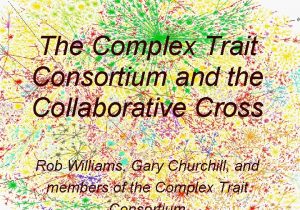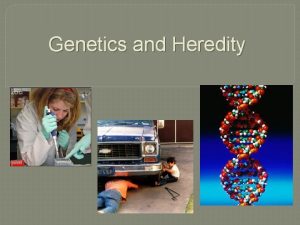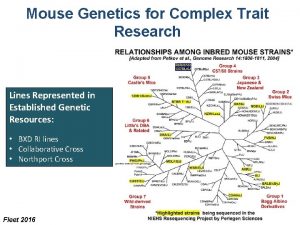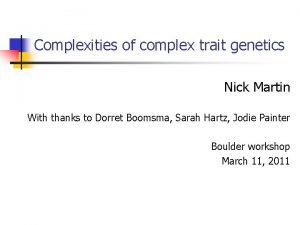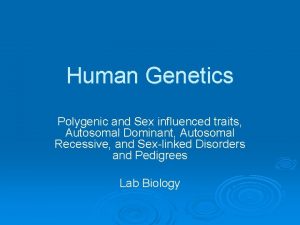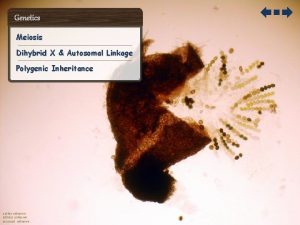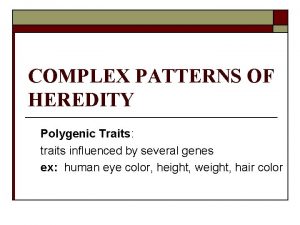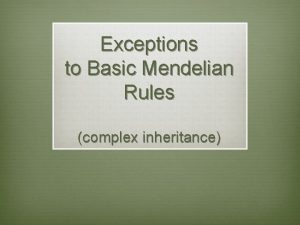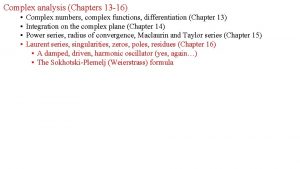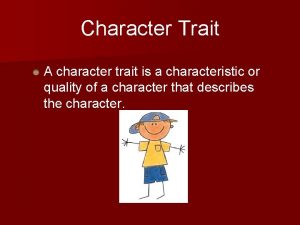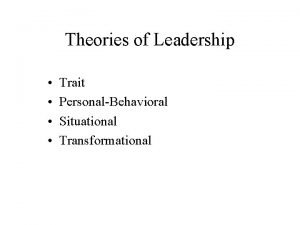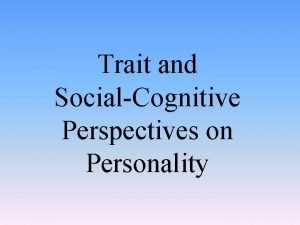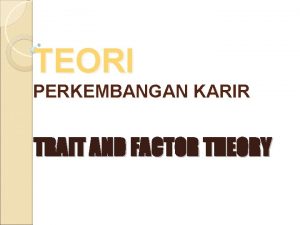Polygenic methods in analysis of complex trait genetics

































![Power & accuracy of PRS’s Ndiscovery E[r 2 target] Ntarget no influence E[r 2 Power & accuracy of PRS’s Ndiscovery E[r 2 target] Ntarget no influence E[r 2](https://slidetodoc.com/presentation_image_h/b029495bd7c1a7f7e7eb40b95e72cde0/image-34.jpg)






![Regression estimates of 2 h 2*[COR(MZ)-COR(DZ)] = h 2 = slope (the slope of Regression estimates of 2 h 2*[COR(MZ)-COR(DZ)] = h 2 = slope (the slope of](https://slidetodoc.com/presentation_image_h/b029495bd7c1a7f7e7eb40b95e72cde0/image-41.jpg)

















- Slides: 58

Polygenic methods in analysis of complex trait genetics Matthew Keller Luke Evans University of Colorado at Boulder

Polygenicity in complex traits n n n The sum of R 2 of significantly associated SNPs of complex traits typically < 10%, despite twin/family h 2 ~. 5 +/-. 2. Why? One possibility: large number of small-effect (~ the 'infinitesimal model'; Fisher, 1918) causal variants (CVs) that failed to reach genome-wide significance (many type-II errors) Growing consensus: 100 s to 1000 s of CVs contribute to the genetic variation of traits like schizophrenia, each with small effects (OR < 1. 3), often in unpredicted loci

Should we continue to do candidate gene research on complex traits?

Should we continue to do candidate gene research on complex traits? NO

Outline n Estimating prediction accuracy of polygenic risk scores (PRS) from GWAS n n history how it works interpretations, uses, & pitfalls Estimating VA explained by all SNPs using genetic similarity at SNPs n n n how it works - HE-regression example walk through of GREML approach practical issues – SNP & individual QC

Outline n Estimating prediction accuracy of polygenic risk scores (PRS) from GWAS n n history how it works interpretations, uses, & pitfalls Estimating VA explained by all SNPs using genetic similarity at SNPs n n n how it works - HE-regression example walk through of GREML approach practical issues – SNP & individual QC

History of PRS • In the dark ages of complex trait genetics (04 -09), many geneticists had lost all hope of finding a way to get their N=3 k GWAS samples published.

History of PRS • In the dark ages of complex trait genetics (04 -09), many geneticists had lost all hope of finding a way to get their N=3 k GWAS samples published. • Then, in 2009, a giant in our field, Sean Purcell, decided to look at the conglomerate effects of thousands of SNPs on a trait and found signals. The floodgates opened.

History of PRS

History of PRS Polygenic Risk Score (PRS) – aka – the “Purcell” approach

History of PRS Polygenic Risk Score (PRS) – aka – the “Purcell” approach

History of PRS Polygenic Risk Score (PRS) – aka – the “Purcell” approach aka – the David Evans Polygenic Risk Score Ingenious (DEPRSING) Approach

Polygenic Risk Score (PRS) Steps 1. 2. 3. 4. 5. 6. 7. Obtain GWAS summary statistics (p-values and β’s) in largest possible discovery sample Obtain independent target sample with genomewide data Use SNPs in common between the two samples. (Optional) Deal with association redundancy due to LD. Restrict to SNPs with p < various thresholds (1 e-5, 1 e 4… 0. 5. . . 1. 0). Construct PRS = sum of risk alleles weighted by β from regression. Regress trait in target sample onto PRS. Evaluate strength of this association (r 2 or h 2 in liability threshold model).

Step 1–GWAS in discovery sample Psychiatric Genomics Consortium, Nature, 2014

Polygenic Risk Score (PRS) Steps 1. 2. 3. 4. 5. 6. 7. Obtain GWAS summary statistics (p-values and β’s) in largest possible discovery sample Obtain independent target sample with genomewide data Use SNPs in common between the two samples. (Optional) Deal with association redundancy due to LD. Restrict to SNPs with p < various thresholds (1 e-5, 1 e 4… 0. 5. . . 1. 0). Construct PRS = sum of risk alleles weighted by β from regression. Regress trait in target sample onto PRS. Evaluate strength of this association (r 2 or h 2 in liability threshold model).

Step 2 – Crucial: target & discovery samples are independent n If non-independence between discovery & target, r 2 target will be overestimated n n n If some of the same people are in both If there are close relatives between the two If you preselect most significant SNPs in target + discovery sample first, then follow the normal PRS procedures

Why non-independence inflates r 2 n n n If null true, E(r 2 discovery) ≅ 1/N. (This is also E[r 2 target] if no PRS association) m unassociated, uncorrelated SNPs, E(r 2 discovery) ≅ m/N If choose the m most associated SNPs of 100 K, the problem is even worse.

Why non-independence inflates r 2 n n n If null true, E(r 2 discovery) ≅ 1/N. (This is also E[r 2 target] if no PRS association) m unassociated, uncorrelated SNPs, E(r 2 discovery) ≅ m/N If choose the m most associated SNPs of 100 K, the problem is even worse. E(r 2 discovery) = Wray et al, 2013. Pitfalls of predicting complex traits from SNPs.

Why non-independence inflates r 2 n n If null true, E(r 2 discovery) ≅ 1/N. (This is also E[r 2 target] if no PRS association) m unassociated, uncorrelated SNPs, E(r 2 discovery) ≅ m/N If choose the m most associated SNPs of 100 K, the problem is even worse. E. g. , Ndiscovery=10 k. E(r 2 discovery) ≅. 10 if choose m=1 k randomly, but E(r 2 discovery) ≅. 60 if choose m=1 k biggest

Why non-independence inflates r 2 n n n If null true, E(r 2 discovery) ≅ 1/N. (This is also E[r 2 target] if no PRS association) m unassociated, uncorrelated SNPs, E(r 2 discovery) ≅ m/N If choose the m most associated SNPs of 100 K, the problem is even worse. E. g. , Ndiscovery=10 k. E(r 2 discovery) ≅. 10 if choose m=1 k randomly, but E(r 2 discovery) ≅. 60 if choose m=1 k biggest If q proportion of target sample that overlaps, E(r 2) in that part of sample is same as in discovery sample. Thus under null: E(r 2 target) ≅ q*r 2 discovery + (1 -q)*1/Ntarget

Polygenic Risk Score (PRS) Steps 1. 2. 3. 4. 5. 6. 7. Obtain GWAS summary statistics (p-values and β’s) in largest possible discovery sample Obtain independent target sample with genomewide data Use SNPs in common between the two samples. (Optional) Deal with association redundancy due to LD. Restrict to SNPs with p < various thresholds (1 e-5, 1 e 4… 0. 5. . . 1. 0). Construct PRS = sum of risk alleles weighted by β from regression. Regress trait in target sample onto PRS. Evaluate strength of this association (r 2 or h 2 in liability threshold model).

Step 3 – Use SNPs in common Array Data Illumina 1 M Imputed Data Affy Axiom If discovery & target on different arrays, use imputed data to maximize overlap

Polygenic Risk Score (PRS) Steps 1. 2. 3. 4. 5. 6. 7. Obtain GWAS summary statistics (p-values and β’s) in largest possible discovery sample Obtain independent target sample with genomewide data Use SNPs in common between the two samples. (Optional) Deal with association redundancy due to LD. Restrict to SNPs with p < various thresholds (1 e-5, 1 e 4… 0. 5. . . 1. 0). Construct PRS = sum of risk alleles weighted by β from regression. Regress trait in target sample onto PRS. Evaluate strength of this association (r 2 or h 2 in liability threshold model).

Step 4 – Account for LD n n CVs inflate associations of nearby SNPs they are in LD with redundant signals. Thus: n r 2 target depends strongly on distribution of SNPs n Diminishes genomewide signal interpretation Typically, people account for LD (worst to best): n LD prune – but can lose strongest signals n LD clumping – preferentially leave in strongest signals, prune out weaker ones in LD n Model LD – LDpred (Vihjalmsson et al, AJHG, 2015)

Polygenic Risk Score (PRS) Steps 1. 2. 3. 4. 5. 6. 7. Obtain GWAS summary statistics (p-values and β’s) in largest possible discovery sample Obtain independent target sample with genomewide data Use SNPs in common between the two samples. (Optional) Deal with association redundancy due to LD. Restrict to SNPs with p < various thresholds (1 e-5, 1 e 4… 0. 5. . . 1. 0). Construct PRS = sum of risk alleles weighted by β from regression. Regress trait in target sample onto PRS. Evaluate strength of this association (r 2 or h 2 in liability threshold model).

Step 5 – Use various p thresholds Use p-thresholds from 5 e-8, 1 e-7, … 0. 5. . . 0. Report results from all thresholds

Polygenic Risk Score (PRS) Steps 1. 2. 3. 4. 5. 6. 7. Obtain GWAS summary statistics (p-values and β’s) in largest possible discovery sample Obtain independent target sample with genomewide data Use SNPs in common between the two samples. (Optional) Deal with association redundancy due to LD. Restrict to SNPs with p < various thresholds (1 e-5, 1 e 4… 0. 5. . . 1. 0). Construct PRS = sum of risk alleles weighted by β from regression. Regress trait in target sample onto PRS. Evaluate strength of this association (r 2 or h 2 in liability threshold model).

Step 6: Construct PRS n • • n PRSj = Σ [βi, discovery * SNPij] βi, discovery = effect size in discovery sample from OLS (continuous trait) or logistic reg (binary trait; β = log(OR)) SNPij = # alleles (0, 1, 2) for SNP i of person j in target sample In PLINK, --score.

Polygenic Risk Score (PRS) Steps 1. 2. 3. 4. 5. 6. 7. Obtain GWAS summary statistics (p-values and β’s) in largest possible discovery sample Obtain independent target sample with genomewide data Use SNPs in common between the two samples. (Optional) Deal with association redundancy due to LD. Restrict to SNPs with p < various thresholds (1 e-5, 1 e 4… 0. 5. . . 1. 0). Construct PRS = sum of risk alleles weighted by β from regression. Regress trait in target sample onto PRS. Evaluate strength of this association (r 2 or h 2 in liability threshold model).

Step 7: Evaluation of PRS n n For continuous traits, this is simply the r 2 from an OLS regressing continuous trait ~ PRS in target. Trickier for binary (e. g. , case-control) data. n Nagelkerke’s R 2 often used. But it has unfortunate property of depending on disease prevalence & proportion of cases: Wray et al, 2013. Pitfalls of predicting complex traits from SNPs.

Step 7: Evaluation of PRS n n For continuous traits, this is simply the r 2 from an OLS regressing continuous trait ~ PRS in target. Trickier for binary (e. g. , case-control) data. n n n §see Nagelkerke’s R 2 often used. But it has unfortunate property of depending on disease prevalence & proportion of cases. Not comparable to h 2 as usually estimated Better alternative = h 2 on the liability scale§, which can be found by converting r 2 from an OLS regression of binary trait ~ PRS to h 2. Lee et el. , 2012. Genetic Epidemiology. A better coefficient of determination for genetic profile analysis.

Interpretation of n n n from PRS r 2 target is an estimate of how well one can predict a trait. But prediction accuracy is lower than estimation accuracy. Variance of PRS is a sum of two components per SNP: n n 2 r true component – often 0 or close to 0 error component ≅ V(SNP) * V(Y)/[2*p*q*N] = V(Y)/N Unless N very large (e. g. , millions), error swamps true component, and PRS is mostly noise. Thus, PRS r 2 is a (typically severely) downwardly biased estimate of SNP-h 2 As N ∞, PRS r 2 SNP-h 2

PRS applications Discovery & target samples are… Same disorder Research purpose Demonstrate polygenicity; predict risk Different disorders Demonstrate genetic overlap Target is a subtype of disorder Demonstrate heterogeneity of disorder Target sample has Demonstrate Gx. E environmental risk data
![Power accuracy of PRSs Ndiscovery Er 2 target Ntarget no influence Er 2 Power & accuracy of PRS’s Ndiscovery E[r 2 target] Ntarget no influence E[r 2](https://slidetodoc.com/presentation_image_h/b029495bd7c1a7f7e7eb40b95e72cde0/image-34.jpg)
Power & accuracy of PRS’s Ndiscovery E[r 2 target] Ntarget no influence E[r 2 target] n Ndiscovery power[r 2 target] Ntarget power[r 2 target] For large Ndiscovery (>>10 k), typically sufficient power to detect PRS relationship at α=. 05 with Ntarget >1 k. n Optimal split of Ndiscovery vs. Ntarget: n n n To maximize power, split discovery & target equally To maximize prediction accuracy, maximize Ndiscovery Dudbridge (2013). PLo. S Gen. Power and predictive accuracy of polygenic risk scores

Outline n Estimating prediction accuracy of polygenic risk scores (PRS) from GWAS n n history how it works interpretations, uses, & pitfalls Estimating VA explained by all SNPs using genetic similarity at SNPs n n n how it works - HE-regression example walk through of GREML approach practical issues – SNP & individual QC

Using genetic similarity at SNPs to estimate VA n n Determine extent to which genetic similarity at SNPs is related to phenotypic similarity Multiple approaches to derive unbiased estimate of VA captured by measured (common) SNPs n n Regression (Haseman-Elston) Mixed effects models (GREML) Bayesian (e. g. , Bayes-R) LD-score regression

Regression estimates of 2 h product of centered scores (here, z-scores) (the slope of the regression is an estimate of h 2)

Regression estimates of (the slope of the regression is an estimate of h 2) 2 h

Regression estimates of 2 h COR(MZ) (the slope of the regression is an estimate of h 2)

Regression estimates of COR(DZ) (the slope of the regression is an estimate of h 2) 2 h
![Regression estimates of 2 h 2CORMZCORDZ h 2 slope the slope of Regression estimates of 2 h 2*[COR(MZ)-COR(DZ)] = h 2 = slope (the slope of](https://slidetodoc.com/presentation_image_h/b029495bd7c1a7f7e7eb40b95e72cde0/image-41.jpg)
Regression estimates of 2 h 2*[COR(MZ)-COR(DZ)] = h 2 = slope (the slope of the regression is an estimate of h 2)

Regression estimates of (the slope of the regression is an estimate of h 2) 2 h

Regression estimates of (the slope of the regression is an estimate of h 2) 2 h

Regression estimates of (the slope of the regression is an estimate of h 2) 2 h snp

Interpreting h 2 estimated from SNPs (h 2 snp) n n If close relatives included (e. g. , sibs), h 2 snp ≅ h 2 estimated from a family-based method, because great influence of extreme pihats. Interpret h 2 snp as from these designs. If use ‘unrelateds’ (e. g. , pihat <. 05): n h 2 snp = proportion of VP due to VA captured by SNPs. Upper bound % VP GWAS can detect n Gives idea of the aggregate importance of CVs tagged by SNPs n By not using relatives who also share environmental effects: (a) VA estimate 'uncontaminated' by VC & VNA; (b) does not rely on family study assumptions (e. g. , r(MZ) > r(DZ) for only genetic reasons)

Comparison of approaches for estimating h 2 snp APPROACH (METHOD) ADVANTAGES DISADVANTAGES HE-regression Fast. Point estimates usually unbiased Large SEs (~30% larger than REML). SE estimates biased. Limited model building.

Comparison of approaches for estimating h 2 snp APPROACH (METHOD) ADVANTAGES DISADVANTAGES HE-regression Fast. Point estimates usually unbiased Large SEs (~30% larger than REML). SE estimates biased. Limited model building. GREML (e. g. , GCTA) Point estimates & SEs usually unbiased. Well maintained & easy to use. Limited model-building (e. g. , no nonlinear constraints).

Comparison of approaches for estimating h 2 snp APPROACH (METHOD) ADVANTAGES DISADVANTAGES HE-regression Fast. Point estimates usually unbiased Large SEs (~30% larger than REML). SE estimates biased. Limited model building. GREML (e. g. , GCTA) Point estimates & SEs usually unbiased. Well maintained & easy to use. Limited model-building (e. g. , no nonlinear constraints). GREMLSEM Flexible. Ability to build complex models. Currently too slow (? ) to be feasible for very large datasets.

Comparison of approaches for estimating h 2 snp APPROACH (METHOD) ADVANTAGES DISADVANTAGES HE-regression Fast. Point estimates usually unbiased Large SEs (~30% larger than REML). SE estimates biased. Limited model building. GREML (e. g. , GCTA) Point estimates & SEs usually unbiased. Well maintained & easy to use. Limited model-building (e. g. , no nonlinear constraints). GREMLSEM Flexible. Ability to build complex models. Currently too slow (? ) to be feasible for very large datasets. LD-score regression Requires only summary statistics; mostly robust to stratification/relatedness Does not give good estimates of variance due to rare CVs

GREML Model (here, n=3, q=2 fixed effects, m=3 SNPs) 3 1 -1. 2 -5 = 1 0. 8 2 1 0. 4 observed y design matrix of fixed effects (intercept & 1 covariate) n×m 1. 15 -. 58 -1. 15 + -. 58 1. 15. 58 -. 58 * fixed effects * + design matrix for SNP effects = SNP effects residuals

GREML Model (after removing fixed effects on y) 1. 15 -. 58 -1. 15 -. 64 -2. 58 = -. 58 1. 15. 58 -. 58 3. 21 residuals y * + design matrix for SNP effects = SNP effects residuals

GREML Model (after removing fixed effects on y) 1. 15 -. 58 -1. 15 -. 64 -2. 58 = -. 58 1. 15. 58 -. 58 3. 21 residuals y * + design matrix for SNP effects = SNP effects residuals We aren’t interested in estimating each ui because m >> n usually, and because such individual estimates would be unreliable. Instead, estimate the variance of ui.

GREML Model (after removing fixed effects on y) 1. 15 -. 58 -1. 15 -. 64 -2. 58 = -. 58 1. 15. 58 -. 58 3. 21 residuals y We assume and therefore * + design matrix for SNP effects = SNP effects residuals

GREML Model (we treat u as random and estimate . 41 1. 65 -2. 05 1. 65 6. 66 -8. 28 -2. 05 -8. 28 10. 3 observed n-by-n var/covar matrix of residuals y = . 99 -. 68. 67 -. 33. 00. 34 Genomic Relationship Matrix (GRM) at measured SNPs. Each element = and thus + 1 0 0 1 Identity matrix )

GREML . 41 1. 65 -2. 05 1. 65 6. 66 -8. 28 -2. 05 -8. 28 10. 3 observed var/covar = . 99 -. 68. 67 -. 33. 00. 34 + 1 0 0 1 implied var/covar REML find values of & that maximizes the likelihood of the observed data. Intuitively, this makes the observed and implied var-covar matrices be as similar as possible.

SNP QC • Poor SNP calls can inflate SE and cause downward bias in h 2 snp • Clean data for – SNPs missing > ~. 05 – HWE p < 10 e-6 – MAF < ~. 01 – Plate effects: • Remove plates with extreme average inbreeding coefficients or high average missingness

Individual QC • Remove individuals missing > ~. 02 • Remove close relatives (e. g. , --grm-cutoff 0. 05) – Correlation between pi-hats and shared environment can inflate h 2 snp estimates • Control for stratification (usually 5 or 10 PCs) – Different prevalence rates (or ascertainments) between populations can show up as h 2 snp • Control for plates and other technical artifacts – Be careful if cases & controls are not randomly placed on plates (can create upward bias in h 2 snp)

Big picture: Using SNPs to estimate h 2 n Independent approach to estimating h 2 n n n When using SNPs with same allele frequency distribution as CVs, provides unbiased estimate of h 2 When using common (array) SNPs to estimated relatedness, generally provides downwardly biased estimate of h 2 n n Different assumptions than family models. Increasingly tortuous reasoning to suggest traits aren’t heritable because methodological flaws “Still missing” h 2 (h 2 family – h 2 snp) provides insight into the importance of rare variants, non-additive, or biased h 2 family. But not a panacea. Biases still exist. Issues need to be worked out (e. g. , assortative mating, etc. ).
 Polygenic trait graph
Polygenic trait graph Linked genes and unlinked genes
Linked genes and unlinked genes Polygenic inheritance
Polygenic inheritance Polygenic inheritance
Polygenic inheritance Pleiotropism
Pleiotropism Pauline and bruno have a big argument
Pauline and bruno have a big argument Ghon complex
Ghon complex Compound complex sentence quiz
Compound complex sentence quiz Electra complex vs oedipus complex
Electra complex vs oedipus complex The electra complex
The electra complex Difference between oedipus complex and electra complex
Difference between oedipus complex and electra complex Fabrication of wax pattern
Fabrication of wax pattern Molecular evolutionary genetics analysis download
Molecular evolutionary genetics analysis download Golg11
Golg11 Hadamard's theorem in complex analysis
Hadamard's theorem in complex analysis Complex truss analysis
Complex truss analysis Complex data types in data mining
Complex data types in data mining Fourier transform complex analysis
Fourier transform complex analysis Complex waves
Complex waves Fact finding and analysis
Fact finding and analysis Determine the vertical displacement of joint c
Determine the vertical displacement of joint c Feedback analysis methods
Feedback analysis methods Data in legal research
Data in legal research Data analysis methods
Data analysis methods Industrial psychology jobs
Industrial psychology jobs Inorganic precipitating agents examples
Inorganic precipitating agents examples Methods of factor analysis in research methodology
Methods of factor analysis in research methodology Amortized analysis aggregate method
Amortized analysis aggregate method Input and output design in system analysis and design
Input and output design in system analysis and design Vendor rating methods
Vendor rating methods Metode titrimetri
Metode titrimetri Method of characterization
Method of characterization Methods of evaluating trading area
Methods of evaluating trading area Methods of vibration analysis
Methods of vibration analysis Research methods design and analysis
Research methods design and analysis Writing traits organization
Writing traits organization Hand clasping dominant or recessive
Hand clasping dominant or recessive Indirect character traits
Indirect character traits Valuable intellectual traits
Valuable intellectual traits Type cum trait theory
Type cum trait theory Trait approaches to leadership
Trait approaches to leadership Trait approaches to leadership
Trait approaches to leadership Allport's trait theory
Allport's trait theory Trait
Trait Trait perspective psychology
Trait perspective psychology Fictional character
Fictional character Staxi-2 c/a
Staxi-2 c/a Hair on end appearance x ray
Hair on end appearance x ray Sports confidence model
Sports confidence model Voice trait of writing
Voice trait of writing 6 pillars of character education
6 pillars of character education What are sexlinked traits
What are sexlinked traits Sex linked inheritance punnett square
Sex linked inheritance punnett square X linked diseases
X linked diseases Social cognitive approaches to personality
Social cognitive approaches to personality Behavioral trait
Behavioral trait Nature of personality in psychology
Nature of personality in psychology Anal personality
Anal personality Humanistic theory of personality
Humanistic theory of personality
